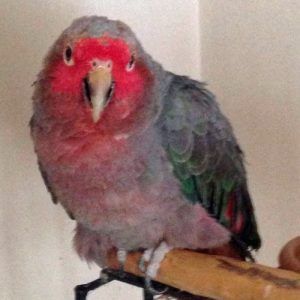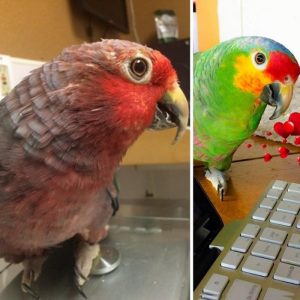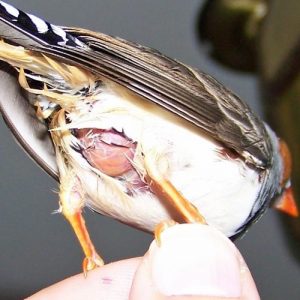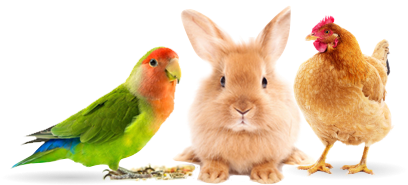Sasha was an 18-year-old, female, pearl cockatiel. Sasha’s owners brought her to see me because she was lethargic and sleeping more than normal. They suspected she might just be getting older and slowing down, but her mate, who was the same age as her, was not any different from normal.
When I examined her, she was overweight, had red pressure sores on her feet, and had a slightly distended belly. Interestingly, her yellow feathers were a very vibrant yellow. The owners reported she had always been an egg-layer and would routinely lay 10 to 12 eggs a year, if not more. Recently, her egg laying activities were reduced, though she still acted like she wanted to lay.
I asked the owners about her diet. It turned out she was eating all seeds, with very little variety to the seeds she selected. Although there was a mixture in the bag, Sasha only ate about three seed types in the mix. They had been feeding her this diet her whole life. Although her mate ate this diet as well, he was a little better about eating the variety of items in the mix, which consisted of other seeds, oats, and the occasional pellet.
We ran some blood work on Sasha because her history and physical examination findings had me concerned that she could have certain organ and nutritional disorders. The blood work results confirmed my suspicions. Sadly, the limited types of seeds Sasha selected from her diet had finally caught up with her. They were not only causing her lipid levels to be sky-high from all the fat that they contained, but they were also causing her calcium levels to drop, as seeds are notoriously known for being low in calcium. Additionally, she had elevations in her liver values. This change was occurring not only because she had a high amount of fat in the diet from the seeds, but also because the diet was missing certain amino acids that, when deficient, can lead to fatty liver syndrome in birds.
Her other issues were likely linked to a poor diet as well. The red feet she suffered from was probably due to two issues: a lack of vitamin A in the diet and being overweight from a high-fat diet, thus causing too much pressure on her little feet. Her excessive egg laying could have been related to her diet as well. A diet high in fat can make a female bird feel a little more hormonal than a low-fat diet. Also, her calcium levels were not ideal to support her hormonal behavior, and that could have explained her lack of laying recently but still playing the part of being a hormonally active female.
After discussing her physical exam changes combined with her blood work results and history, I sat down with the owners and came up with a plan on how to get this cockatiel girl feeling better. We prescribed calcium supplementation and a liver support medication. We discussed ways to reduce her hormonal drive. But the most critical and important part about our plan for Sasha was to improve her diet. We discussed how this was truly central to the goal of getting her back to health. If we could get her diet improved, we could naturally get her fat levels lowered, her calcium levels raised, and maybe have some reversal to the damage done to her liver.
To get Sasha on a more balanced diet we decided to transition her to a combination of pellets and seeds. We discussed the fact that her current seed mix was not cutting it for her, and we should swap to something that had more variety but allowed her to get the seeds she still desired. Nutri-Berries were a great option for her because they contained the millet seed she loved so very much but delivered a more balanced nutritional profile due to the vitamins and minerals added to them after the seed hull was removed. We also mixed these up with pellets and encouraged the owners to offer some fresh vegetables. Lastly, to get her to start trying these different food options, we went over the exact amount she should be offered daily to prevent her from continuing to just pick out what she wanted to eat. With our strategy set and Sasha’s owners dedicated to her care, they left the office with a plan to return for a follow-up.
Sasha’s owners returned at various times along the way so we could check in and make sure all was going well. We kept a close eye on her weight so that we could make sure she wasn’t dropping too quickly and ensure she was taking to the new diet appropriately. Her owners reported that she was not interested in the pellets initially but took to the Nutri-Berries well. However, after about 1 week with the amount of food she was being offered she started to pick at the pellets and slowly began to like them.
We decided to recheck her blood work at six weeks from the start of the diet change. When the much-anticipated new blood results arrived, we were all very happy. Sasha’s fat levels and calcium value had normalized. She still had a slight increase in her liver values, but they were much better than what they were originally. Her examination was improved as well. Sasha was now a normal weight for a female cockatiel, and the red spots on her feet had resolved.
Sasha really came a long way in a short period of time. And the main change was getting her on a more balanced and healthy diet. Although she did have some lasting changes to her liver and she continues to stay on the liver support medication, her liver values are much better than what they were in the beginning of her journey toward a better diet. Sasha’s behavior dramatically improved as well, and she is living the type of life her owners wanted for her — one that is healthy and happy.
 Converting a pet bird to a balanced diet is a task that many owners have had to take on. Whether it’s because a bird came into the home already eating a poor diet, the bird’s health changed and thus its dietary needs changed, or because the owners just didn’t know that certain foods in excess were not ideal, thousands of pet bird owners have had to work on making changes.
Converting a pet bird to a balanced diet is a task that many owners have had to take on. Whether it’s because a bird came into the home already eating a poor diet, the bird’s health changed and thus its dietary needs changed, or because the owners just didn’t know that certain foods in excess were not ideal, thousands of pet bird owners have had to work on making changes.




 Fresca was not a bird I got to see personally as a patient, but she was seen by a friend of mine, and her tale is one that can only be described as amazing. Fresca spent the first 35 years of her life living on a single perch in a corner of a room. She had been given to a family as a gift, but the family was not ready or committed to having a pet that could live for decades. The excitement she initially brought dulled quickly, and soon Fresca passed her days in boredom and solitude. Thankfully, one day Fresca went to a new home with a parrot-savvy owner who knew something was not right with her. Fresca was a red-lored Amazon, but her coloration was all wrong, which made it hard to truly identify her species. She was gray in areas where she was supposed to be green. Her red feathers were pink. If someone was looking at feather coloration alone, they may have suspected she was a rose-breasted cockatoo and not an Amazon parrot!
Fresca was not a bird I got to see personally as a patient, but she was seen by a friend of mine, and her tale is one that can only be described as amazing. Fresca spent the first 35 years of her life living on a single perch in a corner of a room. She had been given to a family as a gift, but the family was not ready or committed to having a pet that could live for decades. The excitement she initially brought dulled quickly, and soon Fresca passed her days in boredom and solitude. Thankfully, one day Fresca went to a new home with a parrot-savvy owner who knew something was not right with her. Fresca was a red-lored Amazon, but her coloration was all wrong, which made it hard to truly identify her species. She was gray in areas where she was supposed to be green. Her red feathers were pink. If someone was looking at feather coloration alone, they may have suspected she was a rose-breasted cockatoo and not an Amazon parrot! Lastly, I will share with you the tale of my personal pet, Leonardo DaFinci. Leonardo was a hand-tamed, male zebra finch who I had hand-reared from just a few days of age after his mother passed away unexpectedly. I got him before veterinary school, when I was an undergrad in college, and didn’t know that he really should be eating more than seeds. I weaned him on to seeds thinking it was the best thing for him. After all, the bag of seeds at the pet store had a zebra finch on it, so I must be giving him the best stuff out there! Well, I was wrong.
Lastly, I will share with you the tale of my personal pet, Leonardo DaFinci. Leonardo was a hand-tamed, male zebra finch who I had hand-reared from just a few days of age after his mother passed away unexpectedly. I got him before veterinary school, when I was an undergrad in college, and didn’t know that he really should be eating more than seeds. I weaned him on to seeds thinking it was the best thing for him. After all, the bag of seeds at the pet store had a zebra finch on it, so I must be giving him the best stuff out there! Well, I was wrong. I went home and tried offering my African grey’s pellets to Leonardo, but they were obviously too large for him. I tried crushing these pellets up, but he really just picked around them and went for the seed that I was offering. I tried a smaller size of the same pellet brand, but he still had no interest. I tried a different brand. I pretended to eat the pellets myself. I had him watch my African grey eat pellets. I tried to offer him only pellets in the morning and not give him the seed, but then he just went on a hunger strike. By noon I was pouring the seeds in his bowl because I thought he was famished and on the verge of dying from starvation! This went on for months. I would try something, he wouldn’t eat it, I would panic, and we were back at the seeds. How was I ever going to get my little guy on the road to good health?
I went home and tried offering my African grey’s pellets to Leonardo, but they were obviously too large for him. I tried crushing these pellets up, but he really just picked around them and went for the seed that I was offering. I tried a smaller size of the same pellet brand, but he still had no interest. I tried a different brand. I pretended to eat the pellets myself. I had him watch my African grey eat pellets. I tried to offer him only pellets in the morning and not give him the seed, but then he just went on a hunger strike. By noon I was pouring the seeds in his bowl because I thought he was famished and on the verge of dying from starvation! This went on for months. I would try something, he wouldn’t eat it, I would panic, and we were back at the seeds. How was I ever going to get my little guy on the road to good health?